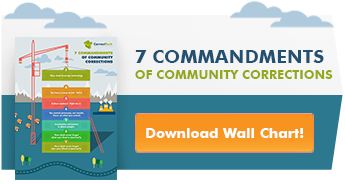This is the 3rd of a 12 part series on Evidence Based Principles. Subscribe to our blog and get the series delivered right to your inbox.
Principle 1b: Assess Actuarial Risk/Need and Responsivity
 What exactly is “actuarial” anyway? “Actuarial” refers to a set of statistics that calculate probabilities of a specific event. The reason probability statistics are emphasized is because human judgment regarding the risk of future crime is typically quite bad, in part because emotions and other biases (see our Risk Principle-Simplified for a more detailed discussion) get in the way. Many authors have done an admirable job of describing the Risk, Need, and Responsivity (RNR) principles. Perhaps it is due to our industry’s creative words (e.g.,“criminogenic” means crime-creating), but our experience is that trainees struggle to truly understand the concepts and have an even tougher time applying it to their daily operations and worldview.
What exactly is “actuarial” anyway? “Actuarial” refers to a set of statistics that calculate probabilities of a specific event. The reason probability statistics are emphasized is because human judgment regarding the risk of future crime is typically quite bad, in part because emotions and other biases (see our Risk Principle-Simplified for a more detailed discussion) get in the way. Many authors have done an admirable job of describing the Risk, Need, and Responsivity (RNR) principles. Perhaps it is due to our industry’s creative words (e.g.,“criminogenic” means crime-creating), but our experience is that trainees struggle to truly understand the concepts and have an even tougher time applying it to their daily operations and worldview.
Some of this difficulty may be that some of the principles seem counterintuitive. For example, many community corrections professionals cannot wrap their brain around the concept that providing too much treatment can be a bad thing. Even seasoned therapists sometimes feel uncomfortable discussing the RNR concepts. Seen as something foreign (it was developed in Canada after all) and unsophisticated, clinicians can fail to see it as a case formulation approach to offenders. They are often adept at discussing an “underlying mechanism” or “core issue” but when RNR enters the conversation, they feel out of their comfort zone quickly. Actually, the RNR concepts are very much developed out of common sense and congruent with any case formulation approach. When you think about the risk, need, and responsivity concepts in terms of visiting a medical doctor, it makes perfect sense.
What does the client need?
- What is the presenting symptom?
- What is causing the symptom?
- Target the underlying cause or the symptom or both?
What is the risk involved?
- What is the severity of the condition?
- Is an intervention actually needed?
- What is the risk if no intervention is provided?
- How big of an intervention is needed?
- What are the potential side effects of the intervention(s)?
- How to maximize the treatment effect and minimize the side effect(s)?
How do I maximize the responsiveness to the intervention?
- What interventions are most likely to provide the desired outcome?
- What factors may impact the intervention’s success?
- What is the best intervention for this particular person at this time?
Far from a foreign concept, the RNR principles mirror the assessment process of any other human services field. Identify the symptom, identify the pros and cons of intervention, and identify the personal or situational characteristics that will likely have an impact on the intervention’s success. One of the most important responsivity factors to consider is motivation. Learn more about it in the next blog.
We at CorrectTech would like to wish you and yours a very Happy Holiday and all the best for 2015!
This a 12 part series. Here are all 12 blogs in the series:
- An Introduction to Evidence Based Principles (EBP)
- EBP: Building the Therapeutic Relationship
- Community Corrections Interventions Must Begin with Assessment
- To Be or Not to Be: Framing Offender Motivation
- EBP: How Good is Your Aim?
- Discovering Values in Collaboration
- Practice Makes...Habit
- Structure & Accountability Still Matter!
- Catch Them Being Good!
- It Takes a Community to Transition an Offender
- What Works Anyway? Prove it!
- Feedback Please!



